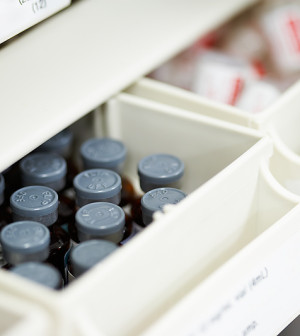- Navigating Your Midlife Crisis: Embracing New Possibilities
- City Raccoons Showing Signs of Domestication
- Mapping the Exposome: Science Broadens Focus to Environmental Disease Triggers
- One Week Less on Social Media Linked to Better Mental Health
- Your Brain Changes in Stages as You Age, Study Finds
- Some Suicide Victims Show No Typical Warning Signs, Study Finds
- ByHeart Formula Faces Lawsuits After Babies Sickened With Botulism
- Switch to Vegan Diet Could Cut Your Greenhouse Gas Emissions in Half
- Regular Bedtime Does Wonders for Blood Pressure
- Dining Alone Could Mean Worse Nutrition for Seniors
Mouse Study Offers Hope for Vaccine Against Chlamydia

A new Canadian study with mice suggests there is hope for a vaccine to protect against chlamydia, a common, sexually transmitted infection that can render young women infertile if left untreated.
The vaccine works by interrupting the process by which chlamydia infects host cells, said senior researcher James Mahony, a professor of pathology and molecular medicine at McMaster University in Hamilton, Ontario.
In female lab mice, the vaccine essentially halted the spread of chlamydia and prevented sterility. However, it should be stressed that animal research often fails to pan out in humans, so further research is needed.
“The vaccine reduced the amount of bacteria in the vagina by about 95 percent” in the rodents, Mahony said. “More importantly, it reduced the pathology [disease] in the fallopian tubes by about 85 percent, which is quite remarkable. That’s probably enough to prevent infertility.”
There currently is no approved vaccine to protect against chlamydia, he added.
Chlamydia causes infertility by damaging the fallopian tubes, the female reproductive structure in which fertilization occurs, Mahony said. A blockage in the tubes can prevent a man’s sperm from reaching a woman’s egg.
Most women — as many as eight out of 10 — do not show any symptoms when they are infected with chlamydia, Mahony said.
“Women who get infected but don’t know they are infected don’t get a diagnosis, don’t get antibiotics, don’t get treated, [and] run the risk of tubal infertility,” he said.
To develop the vaccine, Mahony and his colleagues focused on the protein secretion system used by chlamydia to invade cells.
Chlamydia can only grow inside cells, and so it must invade cells to spread, Mahony explained. When the bacteria comes into contact with a cell, it secretes proteins that penetrate the cell and facilitate the process of invasion.
Out of 20 different proteins involved in the secretion system, the researchers identified three that are crucial to the process.
A vaccine created from these three proteins proved highly effective in protecting female mice from chlamydia, the researchers reported.
The team plans to perform a follow-up study in guinea pigs, and another in monkeys, before moving on to human trials, Mahony said. It will be at least four to five years before the vaccine can be tested in humans.
“It’s going to take a number of years,” he said. “This is just the first step, but it looks very, very promising.”
Human trials for a chlamydia vaccine will be tricky, said Dr. Bruce Farber, chief of infectious diseases at North Shore University Hospital in Manhasset, N.Y., and Long Island Jewish Medical Center in New Hyde Park, N.Y.
“We’re talking about many, many years of development and testing, particularly for a vaccine that’s not going to be easy to test,” Farber said. “Even though it’s a fairly common sexually transmitted disease, it’s not that common that it wouldn’t take a long trial to get this done.”
But if clinical trials are successful, the vaccine could be much more useful, Mahony said.
All strains of chlamydia use the same protein secretion process to invade cells, which means this vaccine should also protect against strains that cause blindness or pneumonia, Mahony explained.
The study is published July 29 in the journal Vaccine.
More information
For more on chlamydia, visit the U.S. Centers for Disease Control and Prevention.
Source: HealthDay
Copyright © 2025 HealthDay. All rights reserved.










